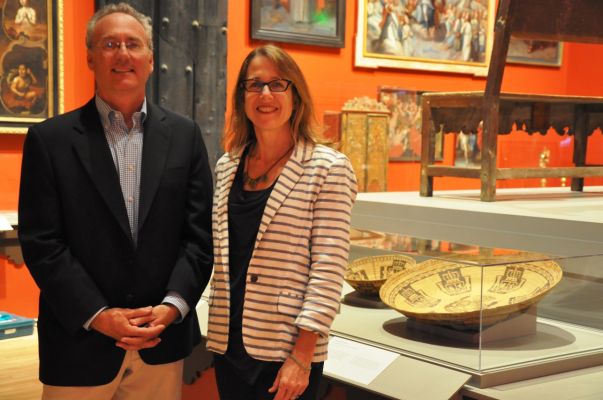Source: UCR Today

RIVERSIDE, Calif. — A first-of-its-kind exhibition documenting the life of the Franciscan missionary who founded California’s mission system and the missions’ impact on California Indians and culture — curated by UC Riverside history professors Steven Hackel and Catherine Gudis — opens Saturday, Aug. 17, at the Huntington Library, Art Collections, and Botanical Gardens in San Marino.
The exhibition — “Junípero Serra and the Legacies of the California Missions” — is unprecedented in its examination of the spiritual and intellectual influences on Junípero Serra’s life that led to his founding of the mission system in California; the transition for thousands of Indians from village to mission life and their responses to it; romantic notions of California born amid myrid myths of mission life; and responses of contemporary Indians, in art and recorded interviews, to the experience.
Hackel, whose research focuses on the history of early California and California Indians, and Gudis, director of UCR’s Public History Program, approached the Huntington Library three years ago with a proposal to develop a modest exhibition that would open this year, 300 years after Serra’s birth in Mallorca, Spain. Hackel also is the author of “Junípero Serra: California’s Founding Father” (Hill and Wang, September 2013).
The exhibition grew to 261 rare documents, artifacts and art from Spain, Mexico and California. Some of the items are on exhibit in the United States for the first time. The exhibition continues through Jan. 6, 2014.
“We wanted to create an exhibition that suggests the contours of his life, beginning in the place he came from,” Hackel explained. “People were starving while he was in Mallorca. How you made food determined who you were as a person in his eyes,” and that philosophy was reflected in the self-sufficient design of a mission system that stretched from San Diego to Monterey.
Serra was born Nov. 24, 1713, in Mallorca, Spain, and died Aug. 28, 1784, at Mission San Carlos Borromoéo del rio Carmelo, Carmel-by-the-Sea. He arrived in Mexico at age 36, and was 55 when he established the first of California’s 21 Spanish missions in 1769.
The exhibition features religious art, diaries and Bibles, letters, maps and reliquaries that provide the context for Serra’s early years as a Franciscan priest, his deployment to Mexico as missionary and agent of the Spanish Inquisition, and the work that occupied his final years: establishing the first nine of 21 Spanish missions in Alta California.
The experience of mission Indians figures prominently as well, with art that illustrates their treatment from the perspectives of Native Americans and Franciscan missionaries, including coercion that Hackel said was central to the experience of many mission Indians; examples of the craftsmanship of Indian carpenters, stone masons and basket weavers; and artifacts such as a 9,000-year-old textile fragment believed to be from a child’s sandal.
“We wanted to demonstrate that California Indians had a history and culture that were ancient and rich, long before the Spanish arrived,” Hackel said.
Vital records compiled by the Franciscans document the lives of 81,000 Indians who were baptized, married or buried at the missions. Those records form the basis of one display that projects the name of every Indian associated with a mission, and a video that documents the movement of individual Indians from villages to missions. The video project, funded by two digital humanities grants from the National Endowment for the Humanities totaling $75,000 and the UCR College of Humanities, Arts and Social Sciences, used mapping software to document the transition of California Indians from village to mission life between 1769 and 1840.
Another video Hackel and Gudis wrote and produced, “Contemporary Voices,” records descendents of the mission Indians discussing the impact of the mission system on themselves and their culture.
The exhibition also documents the evolution of mission mythology that began in the late 19th century that romanticized the experience and prompted tourists to visit California. Entrepreneurs like Frank Miller capitalized on the public fascination with the mission period by building hotels like the Mission Inn in Riverside, giving birth to the mission revival style of architecture that persists in subdivisions today.
The name of every Indian recorded by Franciscan missionaries is projected on a wall at The Huntington Library.
“We see the branding of the missions as a source of commerce,” Gudis explained. “The birth of mass tourism is part of the story as Californians tried to determine what their past was. Do they focus on a Spanish past? Is it Americans following in their footsteps and civilizing an unruly land? Is it sentimentalizing Native Americans as having lived in the past, but not in the present?”
The Huntington Library, Art Collections, and Botanical Gardens is a collections-based research and educational institution serving scholars and the general public, located at 1151 Oxford Road, San Marino. For information about hours and cost of admission go to www.huntington.org.
